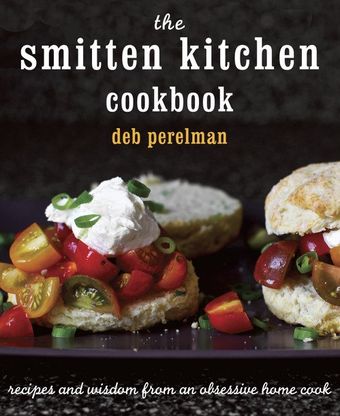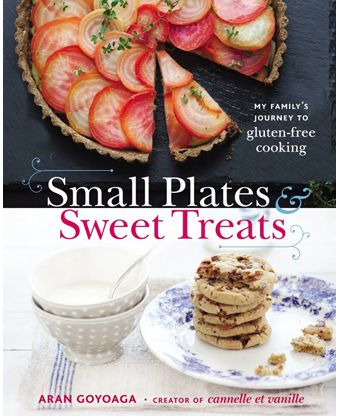I hate dust jackets. I mean, I HATE dust jackets. Don’t you? You should.
Both of the books I was given to judge have dust jackets, just so you know. Right away I was wary of both of them -- sorry, but it’s true; I judged books by their covers and I lived to tell the tale.
I immediately removed both aforementioned paper offenders and felt immensely better. Cookbooks should be as beautiful as art books, as far as I’m concerned, and most of the time the design level is in the basement. What’s up with that?
At first flip, both books felt pretty similar to me. They’re roughly the same size and thickness, printed on the same kind of papers that are cost effective and don’t feel particularly special or tactile.
I know both authors are bloggers and I’ve heard of Smitten Kitchen, but I’m embarrassed to say that even though I’m the Art Director at a food magazine I don’t get into food blogs much. (Food Instagrams on the other hand? I am kind of obsessed.) So I didn’t really start with an impression about these gals either way.
My first weekend with the books I kept wanting to look through Small Plates & Sweet Treats. It had a pretty cover (once it was sans dust jacket, that is), cute, colorful endpaper, and although they chose to print on a high-gloss paper (shudddder), the photos made me hungry (this is the number one rule of food photography, let’s get real), and the props and palette were bright and fun.
The design of the book isn’t really my taste but it has a charm to it, although I don’t support the decision to constantly flop the ingredient list from the left to the right of the instructions. In food, choosing form over function can be a mistake -- in this case, you need the ingredients first, and then the steps for what to do with them.
The Smitten Kitchen Cookbook, on the other hand, was not really grabbing me; looks-wise, it’s all so DARK. Like, shot in the dark, in a dark room, with the brightness taken OUT in Photoshop. Why so glum? There’s a difference between ambiance and poor color correction, and I fear that this book suffers from the latter. That made it harder to feel hungry (read: want to cook anything) when I flipped through. The cover, with dust jacket or without, is not exciting to me. But worse than that: the interior layout is bad. I don’t want this to be a straight up takedown, but the design reads as dated and makes the content seem pretty boring. Visually, it was hard to get through.
At this point maybe you think you know which one I picked and why. And you’d be wrong, because then I cooked. (TWIST!)
From Small Plates I made the Autumn Panzanella Salad and the Red Bean, Chorizo & Short Rib Stew. I invited friends over to eat the surely-to-be-delicious fruits of my labor. Spoiler alert: it didn’t go very well. The panzanella was delicious, but it requires the peeling and quartering of ten baby beets. In case you were wondering, peeling tiny beets sucks. And it takes some time. And after you spend all of that time and you have a pile of ruby shards that want to stain everything in your life, you have a leeeetle mound of...peeled and quartered beets. That just get tossed into a salad with other roasted veg. It seemed like an extraordinary amount of effort and time for something that tasted good but didn’t change my life.
The stew was, how do you say, a disaster. I followed her directions to a T, and instead of the beautiful clear broth with beans and delicious chorizo chunks that is pictured on page 93, I ended up with a puce sludge that tasted decent but made my friends look at me like I was trying to punish them. Not great. (Full disclosure: After the stew disaster, I brought the book into Bon Appetit and asked all of my talented coworkers what I did wrong, and there was a consensus that there are perhaps a few directions missing in how to properly execute dried beans. I felt slightly vindicated.)
It took me a while to find something I really wanted to eat in The Smitten Kitchen Cookbook. Eventually, I made the frittata (I love frittata! Everyone loves frittata!) and it was delicious, and better -- not a pain. But the real winner, the thing that probably won me over completely, was the Butterscotch Banana Tarte Tatin. This was beyond easy and SO GOOD and fun to make, because puff pastry PUFFS. And all you did was drape it over the top of a pan and put it the oven but all of a sudden you MADE SOMETHING...you know?
In the end, what drew me to the Smitten Kitchen recipes most was the conversational-specificity of her ingredients and recipe instruction. In her Butterscotch Banana Tarte Tatin, she writes that the skillet should be "heavy enough so you fear dropping it on your toes" and that you should use bananas that are ripe, but "preferably without speckles." These are the details I like to know, the kind of details that get a cook through a recipe -- from ingredients to process to finish -- successfully. I feel that the reason a lot of my Small Plates experiments failed is because she wasn't specific enough. (The short rib stew didn’t specify if the short ribs should be bone-in or boneless, for example, or offer any real, comprehensive notes on cooking with dried beans. I need to know this information!).
For this matchup, I have to go with The Smitten Kitchen Cookbook! In my opinion, the book itself is not an object to covet but the recipes are superior to those in Small Plates. I’d call this one a squeaker, though -- I wasn’t in love with either book, but aren’t you glad to know that I let the actual food content win out over my better aesthetic judgement?
I judged books by their covers and I was wrong. (Sort of.)



50 Comments
This review is *PERFECTLY* in keeping with The Morning Review's Tournament of Books, on which this tournament of cookbooks is based. TMR chooses reviewers who may or may not have specific expertise in literature and invites them to give their feedback and judge based on any criteria they choose. It's not meant to be a comprehensive, rigorous testing. And when it comes to book reviews, it's not important that we like or agree with a reviewer or even that we agree with their criteria for evaluation. It is important that we understand what that reviewer's criteria are, and use that understanding to evaluate how seriously we want to take their opinion. This review succeeds on that level. Most of you utterly fail.
Highly stylized photos of millennialis dining in expensive digs . food Porn...all form and no content. If everyone is looking at fonts and photos and dust jackets.. When do they cook? I suppose we should now throw out all those books with no photos. The Craig Claiborne, James Beard, Marion Cunningham, Silver Palate, Maida Heatter books and many more. This reviewer doesn't cook, and never graduated from picture books to chapter books..but wow.. What a great I phone case!
And she did, in fact, cook from both cookbooks. I imagine her lack of professional experience cooking is actually bonus, in a way, for this review, given that most people looking at these cookbooks are not going to be professional chefs.
I would strongly suggest Ms. Spiridakis bother to take the time and effort to cook one of the gluten-free recipes in this book, considering it is subtitled “My Family's Journey to Gluten-Free Cooking.” As a former professional pastry chef who developed an allergy to gluten this IS the point of the entire book. Did the reviewer somehow miss this? All of the gluten-free breads, pastries, and cookies in this book are sheer genius. Aran's knowledge and use of alternative flours is nothing short of miraculous. There has never been a better book on gluten-free baking. Ever.
I have not cooed from the gluten free book but I am excited to get started.